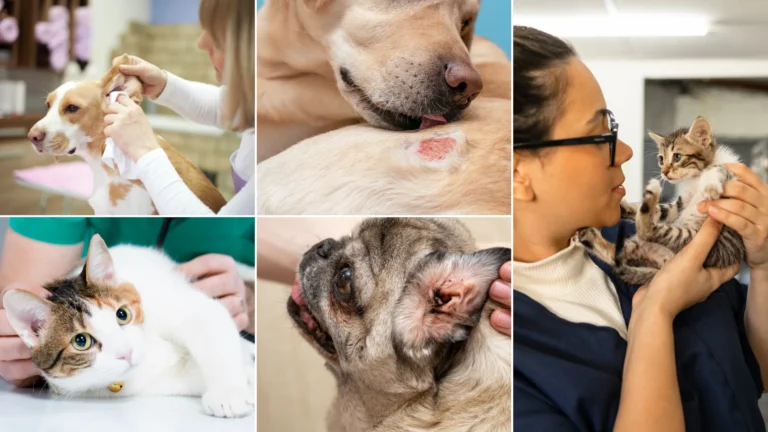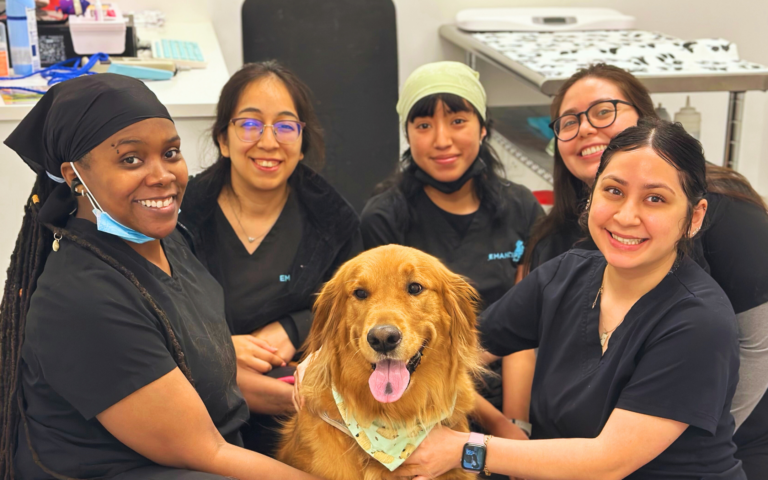What are the dangers of severely cold weather to our pets?
Well, the two biggest cold weather dangers for dogs and cats are hypothermia and frostbite.
Hypothermia & Frostbite
Hypothermia is when the body temperature of a dog or cat drops to a dangerous level. If it goes unchecked, the pet can pass away from being too cold.
Frostbite is exactly what it means for people, and that’s where the tissue becomes so severely damaged from exposure to extreme cold that it could result in permanent disfigurement.
The Two Temperatures to Remember
Two temperatures that I want everyone to remember are 45 degrees Fahrenheit and 32 degrees Fahrenheit. 45 degrees Fahrenheit is the temperature that most preschools use to help determine what is safe for kids to play outside for an extended period of time. And you might notice as you’re traveling down the road, or if you live in a rural area, that’s often the temperature where you’ll start to see blankets on horses and goats and potbelly pigs as you’re traveling by. Some dogs and cats are more sensitive to cold temperatures below 45 degrees. So you may want to think about providing some sort of shelter for them, particularly if they sleep outside.
At 32 degrees Fahrenheit, we need to keep in mind that water and food sources located outside, are most likely going to freeze. So you’ll want to make sure that you can either defrost their food and water or provide them with fresh food and water daily.
If I have an indoor, outdoor, or fully outdoor cat, is it okay for them to be outside?
The short answer is yes, it is okay for a cat to be outdoors, and they need adequate shelter and access to food and water.
So it’s very important that as the temperature drops below 45 degrees and particularly below freezing at 32 degrees Fahrenheit, cats have access to an area where they can get away from winter weather, particularly the wind. Here are some more helpful tips for taking care of community cats during the winter.
Should I put my dog or cat in coats and boots? How can I protect them on walks?
If your dog or cat will tolerate a coat and boots safely, then that is definitely appropriate to put on. However, there are many dogs and cats that will not tolerate that, and in that case, what you’ll want to do is keep a close eye on them while you’re taking your walk.
A Good Rule of Thumb
If it’s cold for people, it’s cold for dogs and cats, so keep a close eye on them. If you see them starting to shiver, if they start to lift a paw in the air, or if they stop moving, those are all signs that it might be too cold and it’s time to turn back.
What should I do if I find a stray dog or cat in the cold?
This question brings up a good reminder – dogs and cats will naturally try to find protection from the elements.
Hiding Under The Hood of a Car
And one thing we need to remember is that cats will often be drawn to vehicles for protection. That means they may climb up into the engine of the car, under a hood, or try to fit between the tire and the rest of the car. So it’s really important in cold winter temperatures to go ahead and tap or really bang on the hood of the car to try to get their attention, and to at least make some vocalization so that you know they’re there.
Where to Take a Stray
If you do happen to find a stray out in the cold temperatures, and you can safely handle the dog or cat, go ahead and bring it inside your home, your garage, to even your car to get it out of the elements. The next step would be to call your local animal control officer.
Should I feed my dog or cat more in the winter for extra protection?
Indoor Pets
If your dog or cat lives primarily indoors, the answer to this question is no. They should be just fine with the normal amount of food that you typically feed them.
Outdoor Pets
If your dog or cat lives primarily outdoors, then yes, you may want to go ahead and feed them a little bit extra.
A good rule of thumb is to feed about a quarter more than what is recommended on the back of the pet food bag. An important thing to remember though, is you’ll want to watch them and keep an eye on their weight to make sure that you’re feeding the appropriate amount. If they look like they’re gaining some weight, go ahead and back off that amount and return to normal portions. If they look like they’re losing weight, you may want to increase the amount.
How do I care for my pet’s paws during the winter?
Some dogs and cats may experience some irritation on their paws during cold, winter weather months, particularly in the Northeast, where salting of roads is very common. So one thing you may want to think about is rinsing, or at least wiping your dog’s and cat’s paws when they come in from the outside to remove any salt.
If you’re starting to see that their paws are becoming excessively red, or they begin to be a little bit tender when you touch them, that may be an indication that they need intervention by a veterinarian.
What should I put in my emergency preparedness kit, such if the power or water is shut off?
This is something that you’ll want to think about, just like you would for yourself and your family. That said, you’ll want to think about the need for water, food, and maintaining their body temperature. So it’s a great idea to have extra water that is bottled, if possible, some food that will not freeze, and extra blankets or bedding on hand. You can also snuggle using your own body temperature and their body temperature to help keep each other warm.
When in doubt, remember that if you’re cold, your pets are cold.




